Overview: Neumann U87 Review
Neumann U87 Ai
OUR RATING:
5.0
(out of 5)
Specs
- Polar Patterns: Cardioid, Omni, Figure-8
- Frequency range: 20 Hz – 20 kHz
- Sensitivity: 20/28/22 mV/Pa ± 1 dB (Omni/cardioid/8)
- Self-noise: 12 dB (A)
- Max SPL: 117 dB (127 with attenuation)
- Impedance: 200Ω
- Weight: 500 grams
Pros
- Delivers transparent, true-to-life (with something extra on top) results
- Tried and tested on a wide range of applications from solo vocals to entire orchestras for over half a century
- Extremely versatile: good on vocals, drum overheads, guitars, amps, strings, ensembles and more.
- The Benchmark Mic for Large-diaphragm studio condensers
Cons
- Expensive
Bottom Line:
An incredible microphone. The TLM 103 and Mojave MA-301 FET are tough, more affordable competitors with a similar sound signature to that of the U87. But still, I’d rather have a U87.
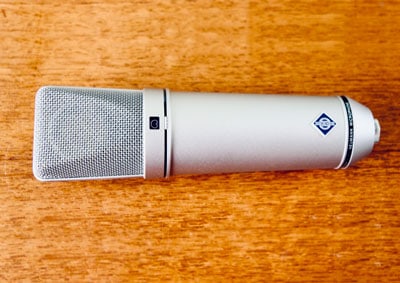
Check Availability and Price in Your Region:
US and Canada
UK and Europe
Introducing the Neumann U87
In case you’ve never heard of the Neumann U87, here’s an intro. This mic is the benchmark for any large-diaphragm studio condenser out there. You will find it in the locker of every big studio.
You have heard this mic. Here’s a few famous people who have gone on to make famous recordings with this mic: The Beatles, The Berlin Philharmonic, Ray Charles, Stevie Wonder, Marvin Gaye, Kurt Cobain, Amy Winehouse, Jeff Buckley, Will.i.am, Bruno Mars, Beyonce… the list goes on.
Despite the Neumann U87 being the most popular studio microphone in the world, we tested it and rated it. We needed to hear the results for ourselves and compare it side-by-side with other mics.
As always, we want to know: is worth it? And how does it compare to the competition?
The U87ai is the latest incarnation of this classic large-diaphragm, FET condenser microphone. We got our hands on one and tested it thoroughly to answer these questions.
See here for all things related to microphones and audio equipment reviews and guides.
Who is this mic for?
The Neumann U87 ai is a microphone for any professional studio or serious recordist. It is a tripolar, side-address, large diaphragm condenser microphone well-suited for the following recording applications:
- Vocals (all styles and voice types)
- Acoustic guitar
- Guitar Amps
- String Instruments
- Drum overheads and drum ambiance
- Piano
- Chamber ensembles
- Choirs
- Orchestras
Who is this mic NOT for?
Regardless of which polar pattern you choose, it is a highly sensitive mic that will require some acoustic preparation of your recording space. The mic is not good at rejecting neighboring noise and not suited to live performance applications.
The U87 is also not ideal for miking solo brass instruments, drum snares, kicks, or toms.
Although many broadcasters do use U87s in their studios, I think this is more mic than you need for spoken word applications.
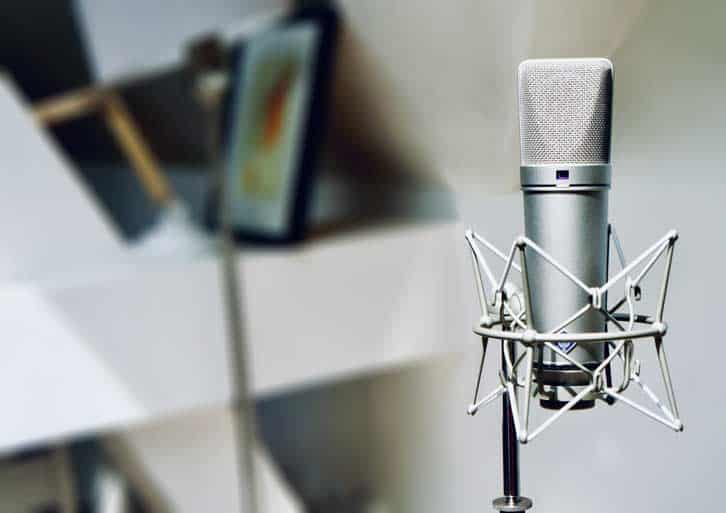
Alternatives to the Neumann U87 ai
Mojave MA-301 FET
A tough, more affordable competitor that uses the same K67-style capsule, and the same circuit (FET-Transformer) as the U87.
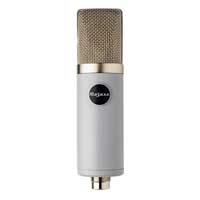
Neumann TLM 103
A fantastic mic designed by Neumann to be a cheaper, transformerless version of the U87.
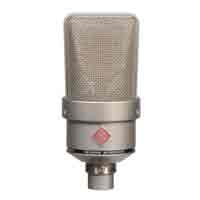
Lauten Eden LT-386
A studio legend with a totally different sonic character to the U87. (CK-12 style capsule, tube transistor)
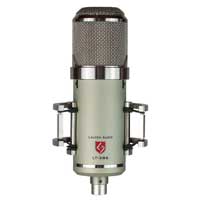
AKG C414 XLII
Another icon of studio mics. As a transformerless mic with 5 polar patterns and a CK-12 capsule, it offers a completely different sonic signature to the U87.
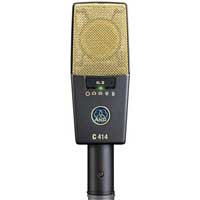
Neumann U67
The predecessor of the U87, with a tube transistor.
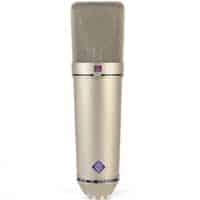
Build/Design
Capsule
The U87 uses a K67 style capsule (It is labeled: K870/K67) with two center-terminated, gold-plated mylar diaphragms placed back to back separated by an aluminum spacer.
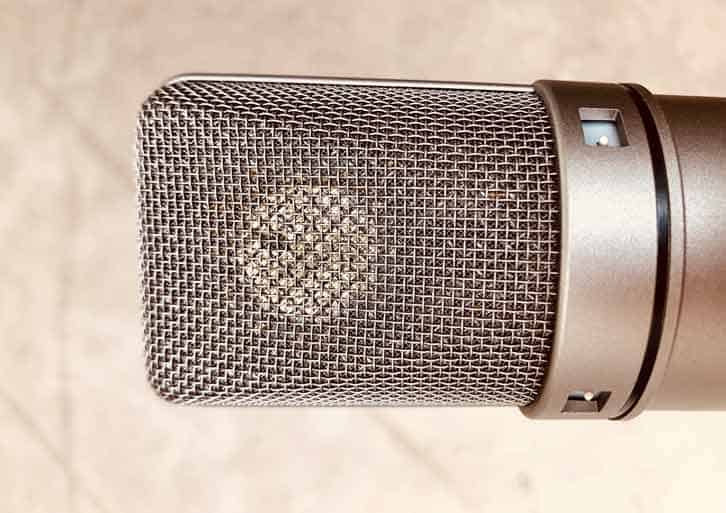
The double-diaphragm design allows the mic to capture sound from all directions. The U87 Ai has three polar patterns: Cardioid, Figure-8, and Omnidirectional.
This capsule is responsible for the overall acoustic character of this mic. The microphone capsule captures and measures the sound and sends the signal onto the circuit part of the mic.
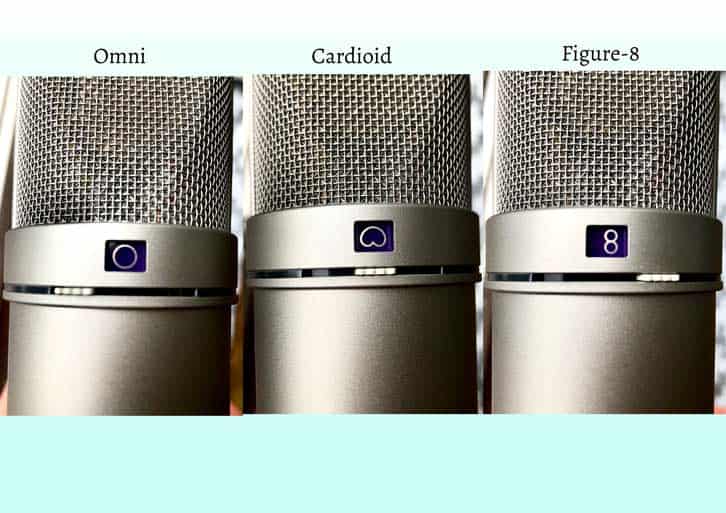
Circuit
The circuit of the U87 Ai uses a FET (field effect transistor) to create a low-impedance signal. In lieu of a bulky external power supply, FET microphones are powered by 48V phantom power which is supplied by most audio interfaces.
This signal is then balanced for analog output by the U87’s transformer. The newer Neumann models, such as the TLM 103 or 102, use a solid-state circuit instead of a transformer. TLM in this case stands for ‘transformerless microphone’.
If you are unsure if your Neumann mic has a transformer or not, you can look at the logo badge. If the logo is purple, it has a transformer. If it is red, it is transformerless.
Altogether, the character of the K67 capsule along with the individual harmonics and colors created by the circuit parts (FET and transformer), gives the U87 its unique acoustic character.
Sound
Neumann U87 Frequency Response Graph
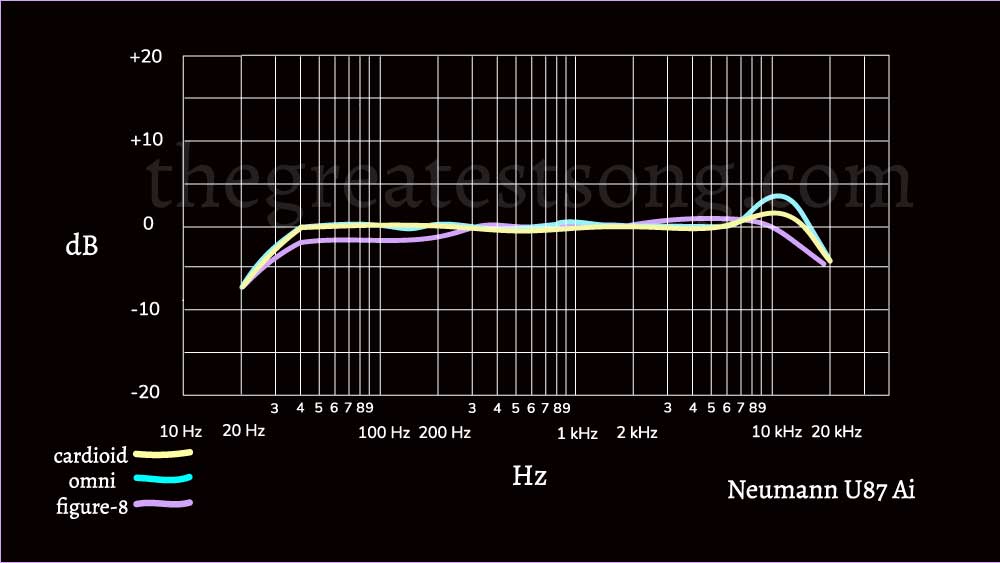
As you can see from the frequency response graph, the response is very linear. Using the cardioid polar pattern, with the exception of a tiny lift for definition in the high frequencies, the U87 ai is a straight line.
The other polar patterns have very small differences in response and hold this straight line, rolling off only at the very top, around 17-20 kHz.
Neumann U87 ai Test Drive
We used a Universal Audio Apollo Solo Interface recorded with Logic Pro X. To give an idea of the raw sound of this mic, we have resisted the urge to make any post-recording adjustments to the tracks. There is no EQ or compression applied to any of the audio clips here. We adjusted the gain from the audio interface to taste. The guitar is a Martin steel-string acoustic (SP000-16TR) and the banjo is a Deering Goodtime.
We include the results from spoken word tests, sung vocals, and acoustic instruments here as they reveal the subtleties of the mics most clearly.
Full disclosure: We fully acknowledge that there is no one way to use a microphone. Mic placement, how you play or sing, not to mention EQ, compression, impedance, and preamp settings can all have dramatic effects on the final result.
Conclusions About the Sound
I have recorded on U87s before and heard their results, but I’ve never had the chance to take the time and test one thoroughly until this week. I was expecting to be disappointed, given the high price tag. But after testing, I officially jump on the bandwagon of U87 lovers.
The brilliance of this mic is its transparency. You’re not dealing with an overhyped, sexy sound. The mic offers instead an elegant, refined malleable result.
Some might be looking to hear a silky, produced sound from an expensive microphone. But that is not how the Neumann U87ai sounds. To my ears, the results are authentic with a little larger-than-life sparkle.
Testing it for different recording applications, its versatility was evident. The polar patterns figure-8 and omni offer breath and distance, while the cardioid pattern feels appropriately intimate.
The proximity effect of the U87, like most large-diaphragm condensers, is pronounced, especially in figure-8 pattern. See here for more info on how proiximity effect can be managed.
Unlike some mics where one has to be completely still while recording, the U87 allowed for natural movement. It produced an even response regardless of a head bob or lyric check.
In the end, I’m just so impressed that without any compression or EQ, the raw results from the Neumann U87ai sound so refined and polished.
History of the Neumann U87
The Neumann U87 is the culmination of developments in condenser microphone technology dating back to the 1920s.
The CMV3
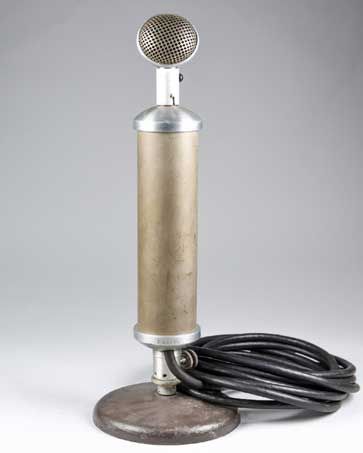
George Neumann founded the company in 1928 and created the first commercially available condenser microphone, the CMV3, also known as ‘The Bottle Mic’.
Sadly, the nickname later became the Hitlerflasche or ‘The Hitler Bottle’ because it was used by the dictator in his public speeches.
The CMV3 brought new possibilities to recording with an extended frequency response that was more linear. While recordings at the time topped out around 3K, the CMV3 could capture frequencies up to 15K.
The U47
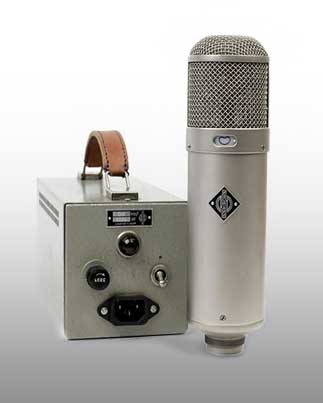
The next step in microphone development came with the invention of the Telefunken U47. George Neumann created this mic and distributed it under the Telefunken name in 1949. (Neumann later took over distribution)
This mic used the CMV3 capsule and was the first ever switchable polar pattern microphone.
Where previously ribbon microphone technology ruled, the U47 brought popular artists like the Beatles and Frank Sinatra over the condenser mic territory.
For its transistor, the U47 used a vacuum tube that soon became difficult to supply. The U47 had won the hearts of many recordists; there was now a market for condenser microphones. The conditions were then primed for the development of a new condenser mic.
U67
The U67 microphone was released in 1960 with the plan that it would take over from the U47. The microphone contained a new capsule, the K67 (the same style capsule found in the U87). The K67 had a two-piece back plate which allowed the diaphragm to be matched for consistent front and rear response.
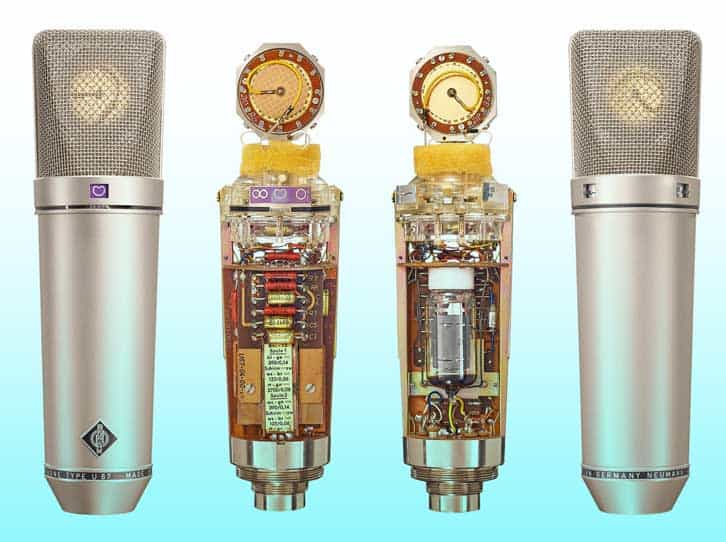
It was designed to have a less forward character which meant less emphasis in the upper mid-frequency range.
This adjustment in frequency response was in response to the shifts in vocal/musical recording styles at the end of the 1950s. Rock and roll singers wanted to use close miking techniques, and the U47 was used in this way to deliver harsh results.
So the Neumann U67 arrived, with tweaks to assuage the new recording techniques. It housed the K67 capsule and a tube transistor-transformer circuit. The U67’s tube transistor, the Telefunken E86, like the U47 still required a sizeable external power supply.
U87
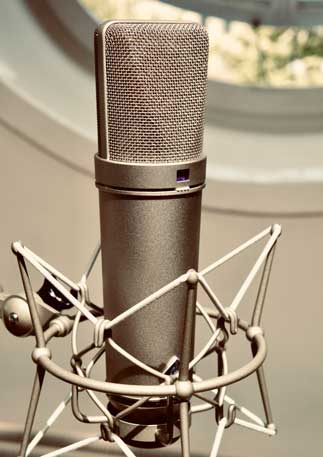
In 1965, Neumann started to make solid-state mics, meaning the tube transistors were replaced with a field effect transistor (or FET).
The advantage was that the mic could now be powered by 48 V phantom power, eliminating the need for a hefty external unit.
In 1967, the Neuman U87 was created as a solid-state version of the Neumann U67 tube mic. It kept the U67 capsule design and replaced the tube circuit with a FET.
The capsule was modified slightly to allow enough power for a figure-8 polar pattern without the use of a DC-DC converter.
The mic has undergone tweaks to its electronic components since the U87 came into being in 1967. In fact, there have been more than 20 variants of the U87 since it came into being (the U87 Ai is the current model). The capsule and its characteristic sound remain essentially the same.
Final Thoughts: Is it worth the Money?
I don’t believe in microphones being inherently good or bad. Instead, it’s just a question of what kind of sound you want to achieve in recording. Something like the Shure 520DX is great at giving you a dirty, nasty result. And the U87 is great at giving you something true-to-life with a little extra larger-than-life bloom.
Technically, the U87 can deliver. That much is indisputable. The advantage this mic has over almost any other mic is that it has been tried and tested for over half a century.
It works and sounds great on a wide range of applications from solo vocals to entire orchestras. And, if you want to know how it sounds on a particular application, consult one of the many famous recordings out there.
That said, the price is high. Critics of the U87 argue that you can buy loads of gear with the money you save by not buying a U87, and that gear can make your sound just as good.
Fans of the U87 say that you cannot beat having a great sound from the source. They argue that they use the U87 all the time and it remains the most reliable piece of gear in their studio.
I believe the TLM 103 (complete review of the Neumann TLM 103) and Mojave MA-201 FET are tough, more affordable competitors with a similar sound signature to that of the U87. But still, I’d rather have a U87.

Neumann U87 Ai
Check Availability and Price in Your Region:
US and Canada
UK and Europe
Questions or Comments?
Follow the discussion here on Facebook.